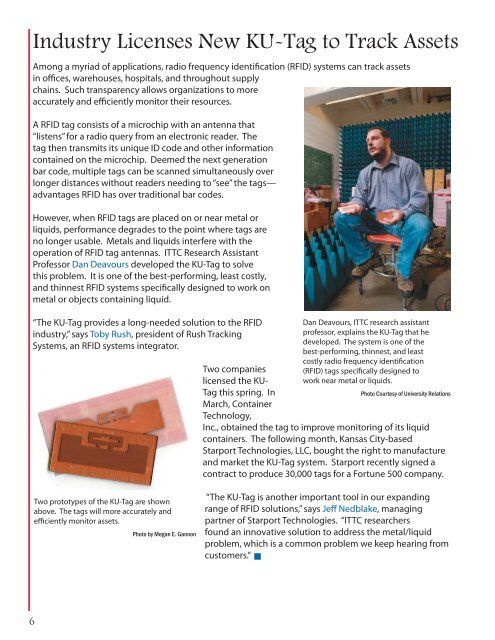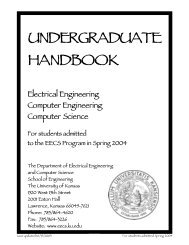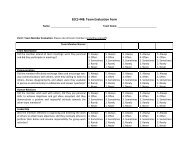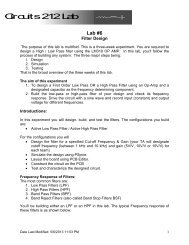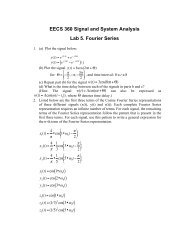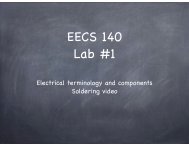EECS News Final 1.30.indd - Electrical Engineering and Computer ...
EECS News Final 1.30.indd - Electrical Engineering and Computer ...
EECS News Final 1.30.indd - Electrical Engineering and Computer ...
Create successful ePaper yourself
Turn your PDF publications into a flip-book with our unique Google optimized e-Paper software.
Industry Licenses New KU-Tag to Track Assets<br />
Among a myriad of applications, radio frequency identification (RFID) systems can track assets<br />
in offices, warehouses, hospitals, <strong>and</strong> throughout supply<br />
chains. Such transparency allows organizations to more<br />
accurately <strong>and</strong> efficiently monitor their resources.<br />
A RFID tag consists of a microchip with an antenna that<br />
“listens” for a radio query from an electronic reader. The<br />
tag then transmits its unique ID code <strong>and</strong> other information<br />
contained on the microchip. Deemed the next generation<br />
bar code, multiple tags can be scanned simultaneously over<br />
longer distances without readers needing to “see” the tags—<br />
advantages RFID has over traditional bar codes.<br />
However, when RFID tags are placed on or near metal or<br />
liquids, performance degrades to the point where tags are<br />
no longer usable. Metals <strong>and</strong> liquids interfere with the<br />
operation of RFID tag antennas. ITTC Research Assistant<br />
Professor Dan Deavours developed the KU-Tag to solve<br />
this problem. It is one of the best-performing, least costly,<br />
<strong>and</strong> thinnest RFID systems specifically designed to work on<br />
metal or objects containing liquid.<br />
“The KU-Tag provides a long-needed solution to the RFID<br />
industry,” says Toby Rush, president of Rush Tracking<br />
Systems, an RFID systems integrator.<br />
Two companies<br />
licensed the KU-<br />
Tag this spring. In<br />
March, Container<br />
Technology,<br />
Dan Deavours, ITTC research assistant<br />
professor, explains the KU-Tag that he<br />
developed. The system is one of the<br />
best-performing, thinnest, <strong>and</strong> least<br />
costly radio frequency identification<br />
(RFID) tags specifically designed to<br />
work near metal or liquids.<br />
Photo Courtesy of University Relations<br />
Inc., obtained the tag to improve monitoring of its liquid<br />
containers. The following month, Kansas City-based<br />
Starport Technologies, LLC, bought the right to manufacture<br />
<strong>and</strong> market the KU-Tag system. Starport recently signed a<br />
contract to produce 30,000 tags for a Fortune 500 company.<br />
Two prototypes of the KU-Tag are shown<br />
above. The tags will more accurately <strong>and</strong><br />
efficiently monitor assets.<br />
Photo by Megan E. Gannon<br />
“The KU-Tag is another important tool in our exp<strong>and</strong>ing<br />
range of RFID solutions,” says Jeff Nedblake, managing<br />
partner of Starport Technologies. “ITTC researchers<br />
found an innovative solution to address the metal/liquid<br />
problem, which is a common problem we keep hearing from<br />
customers.” <br />
6


